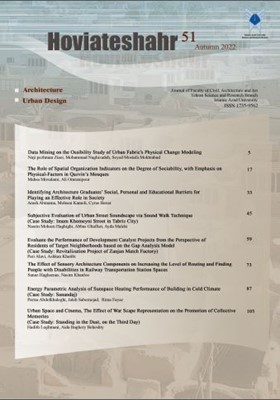Parametric analysis of sunspace heating performance of building in cold climate (Case study: Sanandaj)
Subject Areas : architectureparisa abdekhaleghi 1 , zhale sabernezhad 2 , rima fayaz 3
1 - Faculty of Architecture, Azad University, Kish International Branch
2 - Faculty of Architecture, Azad University, South Tehran Branch
3 - Faculty of Architecture and Urbanism, University of Arts, Tehran
Keywords: Sunspace, Building, Cold Climate, Sanandaj city, Energy performance,
Abstract :
Increasing energy consumption in buildings has result in environmental issues and have led many researchers to explore ways to reduce fossil fuel consumption. One of the most cost-effective and logical ways to use energy resources in residential buildings is to use passive solar systems such as sunspaces.Sunspaces are passive systems that can easily be integrated into the structure of a building, whether it is under construction or already completed. The primary role of passive sunspace systems is to collect solar energy, accumulate it inside, and transfer it to other living areas. In addition, sunspaces also serve as buffer zones, protecting the indoor space from excessive heat loss.The design of building with a sunspace can be improved if the method of energy performance simulation is accompanied by optimization algorithms. Building optimization can include a variety of goals, such as energy, environmental, economic, etc. Use of passive systems in residential buildings can provide a substantial portion of passive solar heating, but the degree of efficiency of sunlight depends on numerous parameters, such as climatic parameters. In this paper, the effects of sunspaces on energy gain and reducing energy consumption are presented. The best known stationary methods, such as those used in the EN ISO 13790 standard do not yield sufficiently accurate results. Dynamic simulation methods that can determine energy needs of buildings more precisely require computer support and more time for the simulation to be performed.The energy performance of the sunspace was calculated using parametric modeling in Grasshopper software and Rhino software and energy simulation was carried out using Energyplus. Simulations were performed according to the climate of the city of Sanadaj,which is located in a cold climate area, Meteorological data considered in the model represent a meteorological year.The proposed method of performance optimization utilizes various tools and technologies including parametric design, building simulation modeling, and Genetic Algorithms. To achieve simulation goals, different models of sunspace with different dimensions and orientations in Sanandaj have been studied. Modifications of the the models included different proportions of sunspace dimensions, orientations, , and the use of different thermal insulations.The orientation, towards the south, receives the highest energy, and with a ,20 degrees rotation to the west or east, the highest amount of energy can be gained. Examination of sunspace models with 3 percentages of window-to-wall ratio: 40%, 50% and 60% showed that the 50% percent WWR is more desirable compared to other models. The highest increase in energy absorption to help reduce the heating load during the cold season occurs when the sunspace has the longest length, ie 5 meters, because in this case, the southward is increased and the desired depth is 1 meter while by reducing or increasing this amount, solar energy gain is reduced. Also, to improve the performance of the sunspace, the use of conventional thermal insulation has been investigated. Polyurethane with a thickness of 10 cm has the lowest efficiency in terms of reducing energy consumption in the sunspace, while other insulating materials with similar thichness are more effective.


